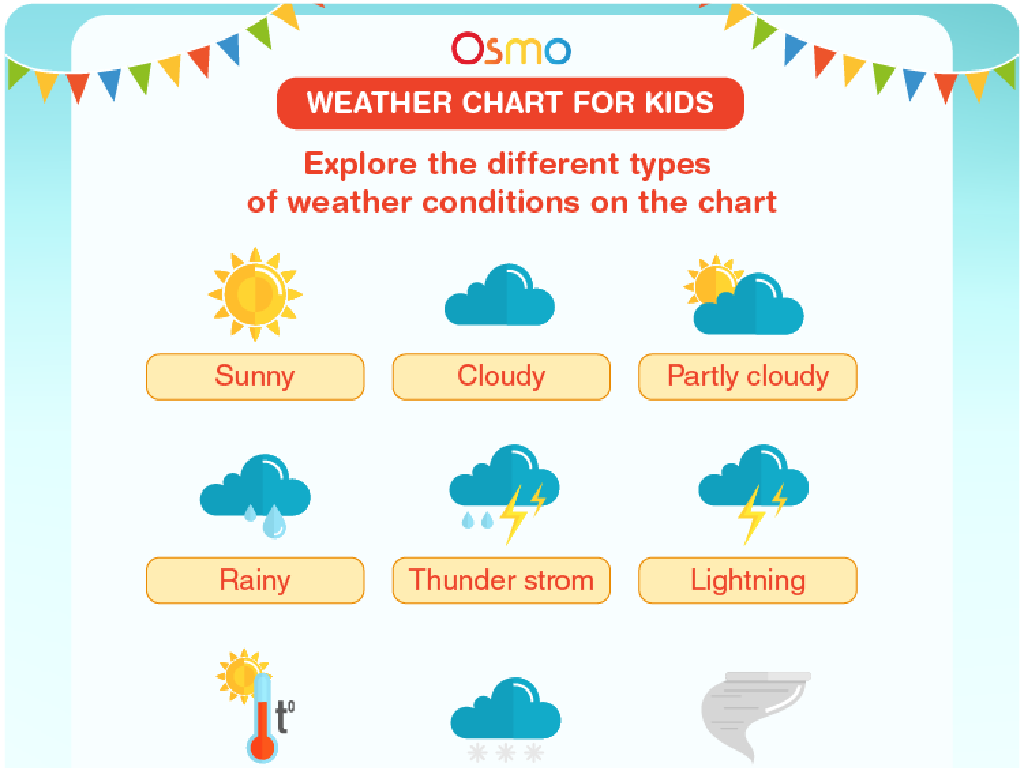Select Countries Of Africa: Review
Subject: Social studies
Grade: Sixth grade
Topic: Africa: Geography
Please LOG IN to download the presentation. Access is available to registered users only.
View More Content
Exploring Africa’s Geography
– Africa’s diverse landscapes
– Deserts, rainforests, mountains, and rivers
– Review of select countries
– Egypt’s Nile, Kenya’s savannas, South Africa’s Cape
– Geography’s role in daily life
– How landforms affect where we live, work, and play
– Connecting geography to culture
– Traditions, food, and clothing influenced by geography
|
This slide aims to captivate the students’ interest in the vast and varied geography of Africa. Highlight the continent’s diverse landscapes, such as the Sahara Desert, Congo Rainforest, and Mount Kilimanjaro. Focus on select countries like Egypt, known for the Nile River; Kenya, famous for its savannas; and South Africa, with its unique Cape region. Discuss how geography plays a crucial role in our daily lives, influencing settlement, economy, and activities. Finally, draw connections between geographical features and cultural aspects like traditions, cuisine, and attire. Encourage students to think about how their own lives are shaped by the geography around them.
Africa’s Geography: Rivers, Mountains, and Deserts
– Major African rivers and mountains
– The Nile, Congo, and Niger rivers; Mount Kilimanjaro and Atlas Mountains
– Explore the Sahara Desert
– World’s largest hot desert, covering North Africa
– The significance of the Nile River
– Longest river in the world, crucial for Egypt’s civilization
– Impact on inhabitants’ lives
– Geography influences farming, settlements, and culture
|
This slide aims to review the major physical features of Africa, including its prominent rivers, mountains, and deserts. Highlight the importance of the Sahara Desert and the Nile River, not only as geographical landmarks but also as key influences on the development and daily lives of the people in Africa. Discuss how these features affect agriculture, settlement patterns, and cultural practices. Encourage students to think about how living near a major river or desert might influence their own lives, drawing parallels to local geography where possible.
Climate Zones of Africa
– Exploring Africa’s climates
– Africa has diverse climates, from deserts to rainforests.
– Comparing countries’ climates
– How are Egypt’s arid conditions different from Congo’s tropics?
– Climate’s impact on life
– Wildlife adapts to survive, like camels in deserts.
– Climate influences culture
– Traditions, clothing, and food vary with climate.
|
This slide aims to give students an understanding of the diverse climate zones in Africa and how they shape the culture, wildlife, and daily life of its people. Start by discussing the various climates found across the continent, from the Sahara Desert’s arid expanse to the tropical rainforests of the Congo Basin. Encourage students to compare and contrast these climates by looking at specific countries. Discuss how the climate has influenced the development of different cultures within Africa, including the types of clothing worn, the food eaten, and the houses built. Highlight how animals have adapted to their environments, such as camels being suited to desert life. This will help students appreciate the relationship between the environment and human activity.
Exploring Africa’s Cultural Diversity
– Africa’s rich cultural tapestry
– Languages, traditions, and arts
– Swahili in Kenya, Arabic in Egypt, Zulu in South Africa
– Geography’s impact on culture
– Desert vs. rainforest lifestyles
– Case studies: Kenya, Egypt, South Africa
– Discuss Maasai culture, Egyptian history, South African music
|
This slide aims to introduce students to the vast cultural diversity found within the African continent. Emphasize that Africa is not a monolith; it’s a continent with a rich mosaic of languages, traditions, and arts. Highlight how the geography of a place can shape the culture of its people, such as how desert cultures differ from those in rainforest regions. Use specific examples from select countries like Kenya’s Swahili language and Maasai culture, Egypt’s long history and Arabic language, and South Africa’s diverse music scene to illustrate these points. Encourage students to think about how their own local geography has influenced their culture as a way to connect with the material.
Economic Activities in African Countries
– Agriculture, trade, and industry overview
– Explore how farming, trading, and manufacturing shape economies in Africa.
– Natural resources impact on economy
– Many African economies rely heavily on natural resources like minerals, oil, and crops.
– Case Study: Cocoa farming in Ghana
– Ghana is one of the world’s leading cocoa producers, a major economic activity.
– Understanding economies through resources
|
This slide aims to give students an understanding of the different economic activities that are prevalent in select African countries. Emphasize the importance of agriculture, trade, and industry, and how these sectors are interconnected. Discuss the significant role natural resources play in shaping the economies of these countries. Use the case study of cocoa farming in Ghana to illustrate how a single natural resource can have a large impact on a country’s economy. Encourage students to think about how the availability of natural resources can influence a country’s trade and industry sectors. Provide examples of other countries and their key economic activities for a broader perspective.
Exploring African Countries: A Review
– Quick facts about selected countries
– Capital, population, language, e.g., Nigeria: Abuja, 200M, English
– Unique features of each country
– Landmarks, climate, e.g., Egypt’s pyramids, Sahara Desert
– Geography’s influence on life
– How landforms, climate affect culture, economy, e.g., farming near Nile
– Examples from different countries
– Compare life in coastal vs. landlocked areas, e.g., Kenya vs. Uganda
|
This slide aims to summarize key information about selected African countries, highlighting their unique characteristics and the impact of geography on daily life. Start with quick facts to give students a snapshot of each country’s identity. Discuss unique features such as historical landmarks, natural resources, and climate. Explain how these geographical aspects influence the culture, economy, and lifestyle of the people living there. Use specific examples to illustrate these points, such as the importance of the Nile River for agriculture in Egypt or the differences in trade opportunities between coastal and landlocked countries. Encourage students to think about how their own lives might be different if they lived in one of these countries.
Class Activity: Create Your African Country
– Form groups to design a country
– Include geography and climate
– Mountains, rivers, deserts, savannas; is it tropical, arid?
– Add unique cultural elements
– Language, traditions, clothing, food
– Present your country to the class
|
This activity encourages students to apply their knowledge of African geography and culture creatively. Divide the class into small groups, each tasked with creating a fictional African country. They should consider the physical geography, such as landforms and bodies of water, and the climate zone, whether it’s tropical, desert, Mediterranean, etc. Cultural elements like language, traditions, clothing, and cuisine should reflect how geography influences lifestyle and society. Each group will present their country, explaining how its geography has shaped its features. This will help students understand the relationship between geography and culture. Possible variations include having each group focus on different regions or aspects of African geography to ensure a diverse set of countries is created.






